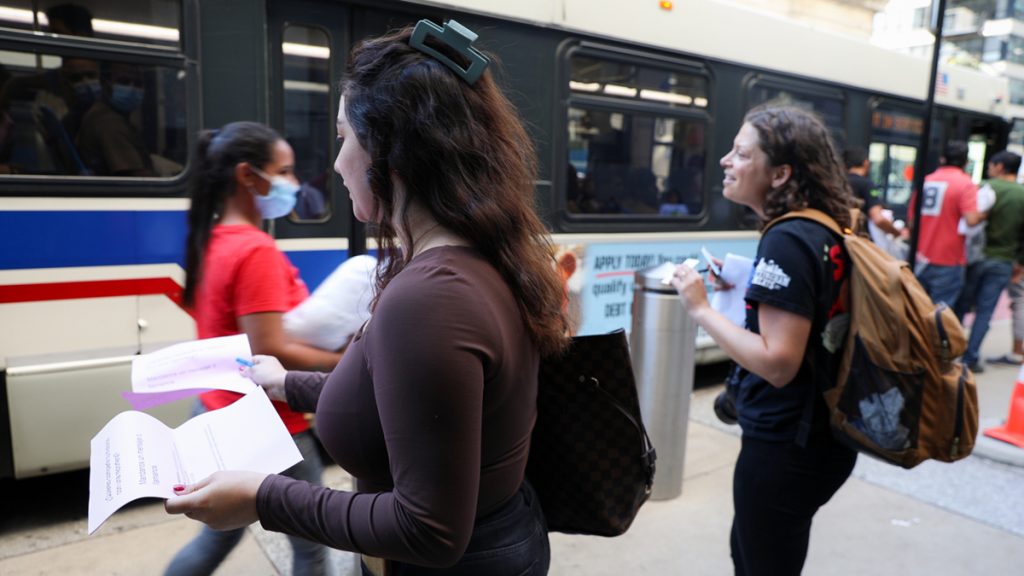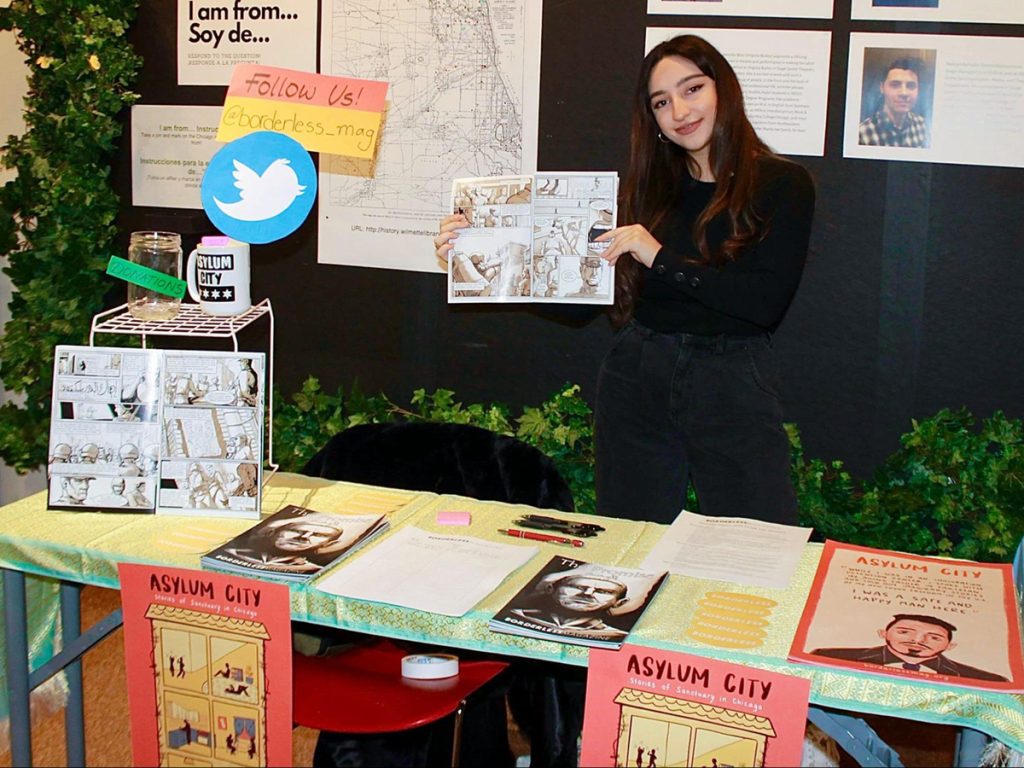
Borderless Magazine’s Engagement Reporter Diane Bou Khalil and Art Director Michelle Kanaar talk to migrants getting off buses at Chicago Union Station in September. Photo: Jesus J. Montero | Borderless Magazine
Why your news outlet needs an on-the-ground strategy
Borderless Magazine’s Diane Bou Khalil shares guidance for meeting community members where they’re at
Borderless Magazine is a digital-native news outlet that reports on and with immigrants in the Chicago area. Community is at the center of everything we do. About half of our audience reads our stories in Spanish and 99% of our stories are reported, illustrated or photographed by people from immigrant communities.
Our unique audience — and their understandable misgivings about journalism and news outlets – means that oftentimes the traditional “best practices” for reaching readers and growing our audience don’t work for us. So we’ve adopted a network approach to reach our readers over the years, leaning on existing pathways of trust (like community leaders) and spending a lot of time offline in the community.
Leading our community work is our engagement reporter Diane Bou Khalil. I first met Diane when I was teaching nights at Northeastern Illinois University and she was my student in my Community Media class. We ended up hiring her as Borderless’ first engagement intern, and today she is a full time engagement reporter who helps us reach our multilingual and diverse audience in Chicago. Diane’s job at Borderless is to get to know our readers and also get to know people who aren’t yet our readers by tabling and speaking to people at community events.
I sat down with Diane to talk about her experiences with on-the-ground engagement.
Rhee: As Borderless’ engagement reporter, you use both online and offline techniques to connect with our community. What makes on-the-ground engagement different from, say, posting on social media?
Bou Khalil: It’s a completely different experience. The internet is accessible worldwide, so we can connect with a wider audience there. But because of this, it’s easy to get caught up in numbers, from keeping track of our pageviews to newsletter subscribers, readers and social media followers.
Being on the ground feels more humane. It gives me a better feel of who the community is, what we’re reporting on, and what they need from Borderless.
Both online and offline engagement work together and they are essential to growing an audience. Oftentimes, I’ll find out about an event or connect to a community member through email or by messaging with them on Facebook or Instagram. Then when I go to that neighborhood or community for the first time, they’ll know who I am or what Borderless is about, but might not trust me yet. By the second or third time I’m in a place talking to people, I’ve gained their trust and people are inviting me into their spaces, telling me stories we should cover and introducing me to their friends.
Rhee: What are the benefits of using an on-the-ground approach? What are the biggest challenges?
Bou Khalil: It’s a great way to get new, engaged audience members. Whenever we do on-the-ground engagement, we get new newsletter subscribers. These people tend to open our newsletter at above average rates. We often give away swag like posters, comic books and stickers when we’re out at events or tabling in the community, so people have something to remember us by. It’s a good way to get people to pay attention to our work.
On the ground can mean so many different things. For us, it can be tabling at a community event, standing outside of a train station talking to people, attending local celebrations and spending a few hours talking to people at a food pantry or church.
A challenge is that on-the-ground work is much more fast paced than online work. You have to work fast, think fast and always be ready. I have my go-bag ready with my Borderless badge, notebook, laptop and camera so I can run out the door if a protest or gathering happens suddenly.

Rhee: Can you give an example of how being on the ground has helped shape news coverage?
When Texas Gov. Greg Abbott began sending buses of migrants to Chicago in early September, I started going to Union Station downtown where the migrants were arriving. The first time I went, it was a lot of waiting and then we had only a few seconds to talk to the migrants from when they got off the bus to when they got on a city bus to go to a shelter. The city officials and nonprofit workers who were helping the migrants were extremely protective of them and it was difficult to find out any information directly from the migrants.
I realized I was only going to have a few seconds to reach out to the migrants, tell them I was a journalist and share my contact information with them in case they wanted to share their story with me. So the second time I went, we made a simple flier to hand out to the migrants. It said in Spanish that I’m a journalist and if they want to share their story with a reporter, they can message us or call us. It also explained that we’re an immigration news outlet and we publish stories in Spanish.
When people getting off the bus saw other migrants with the flier, they asked me for one too. So we were able to reach many more people than if I had gone up a couple people individually in those brief seconds. Through the flier, we were able to get people’s contact information and they called us so we could do a follow up story with them.
Rhee: Earlier this year, we sent field canvassers out to four Spanish-speaking communities in Chicago so that we could better understand their information needs. What was the difference between using them and your regular work as an engagement reporter?
Bou Khalil: As an engagement reporter, storytelling and bringing news to the community is a big part of my job. Field canvassers complement that work. They are a big help when it comes to listening to community concerns and seeing what news is missing in communities.
The field canvassers live in the neighborhoods they were canvassing, spoke Spanish and had a similar background as the people we were trying to reach. They had an incredible advantage in gaining a community’s trust. I don’t speak Spanish — I am a native Arabic speaker — so they could talk to people I couldn’t. And by going out every weekend to table, they ensured we had a regular presence to build relationships and trust with our readers.
By working together, we were able to ensure that Borderless’ coverage is truly serving the immigrant community here in the ways they are asking it to serve them.
Rhee: Do you have any advice for news outlets who want to do more on-the-ground audience work?
Bou Khalil: Don’t take things personally! Sometimes people will yell at you or give you a side eye. It’s not about you. There’s a lot of mistrust of journalists in communities and it’s our job to overcome that.
Also, try to be organized. Take notes about everything you do each week, like how many people you spoke to, what techniques for approaching people worked, and what places seemed the most welcoming to you being there. See if you can find any patterns you can learn from so when you go back out you can be more efficient.
Some on-the-ground work can be less planned, but it’s more effective if you plan ahead and make agreements with community organizations ahead of time to be in their space or work with their members. It makes things easier for the people going out and for your newsroom. But of course, things happen! Sometimes it rains or an event is canceled. You have to be flexible and keep a Plan B in the back of your mind.

Comments